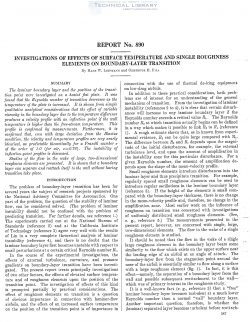naca-report-890

- Version
- 182 Downloads
- 1.14 MB File Size
- 1 File Count
- August 31, 2016 Create Date
- August 31, 2016 Last Updated
National Advisory Committee for Aeronautics, Report - Investigations of Effects of Surface Temperature and Single Roughness Elements on Boundary Layer Transition

The laminar boundary layer and the position of the transi—
tion point were int'estigated on a heated flat plate. It was
found that the Reynolds number of transition decreases as the
temperature of the plate is increased. It is shown from simple
qualitative analytical considerations that the efiect of rariable
viscosity in the boundary layer due to the temperature dtference
produces a relocity profile with an inflection point if the wall
temperature is higher than the free-stream temperature. This
profile is confirmed by measurements. Furthermore, it is
confirmed that, eren with large deriation. from the Blas-ius
condition, the relocity and temperature prtg‘iles are rery nearly
identical, as predictable theoretically for a Prandtl number a
of the order of 1.0 (for air, 0:0.76). The instability of
inflection—point profiles is discussed.
Studies of the flow in the. wake of large, two-dimensional
roughness elements are presented. It is shown that a boundary
layer can separate and reattach itself to the wall without hazing
transition talce place.
The problem of boundary-layer transition has been for
several years the subject of research projects sponsored by
the National Advisory Committee for Aeronautics. One
part of the problem, the question of the stability of laminar
flow, can be considered solved. (The problem of laminar
instability should not be confused with the problem of
predicting transition. For further details, see reference 1.)
The experiments carried out. at the National Bureau of
Standards (reference 2) and at the California Institute
of Technology (reference 3) agree very well with the results
of Lin in a very complete theoretical analysis of laminar
instability (reference 4), and there is no doubt that the
laminar boundary layer first becomes unstable with respect to
small perturbations at. a certain critical Reynolds number R1.
In the course of the experimental investigations, the
effects of external turbulence, curvature, and pressure
gradients on boundary-layer transition have been investi-
gated. The present report treats principally investigations
of two other factors, the effects of elevated surface tempera-
ture and of roughness elements upon the position of the
transition point. The investigation of efiects of this kind
is prompted partially by practical considerations.
| File | Action |
|---|---|
| naca-report-890 Investigations of Effects of Surface Temperature and Single Roughness Elements on Boundary Layer Transition.pdf | Download |

Comment On This Post